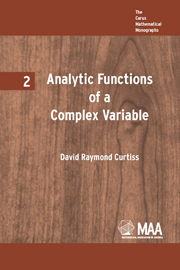Book contents
- Frontmatter
- PREFACE
- Contents
- CHAPTER I ORIGIN AND APPLICATIONS OF THE THEORY
- CHAPTER II COMPLEX NUMBERS
- CHAPTER III REAL FUNCTIONS OF REAL VARIABLES
- CHAPTER IV COMPLEX FUNCTIONS THAT HAVE DERIVATIVES
- CHAPTER V APPLICATIONS IN GEOMETRY AND PHYSICS
- CHAPTER VI INTEGRALS OF ANALYTIC FUNCTIONS
- CHAPTER VII INFINITE SERIES
- CHAPTER VIII SINGULARITIES OF SINGLE-VALUED ANALYTIC FUNCTIONS
- CHAPTER IX ANALYTIC CONTINUATION. MANY-VALUED ANALYTIC FUNCTIONS
- INDEX
CHAPTER VIII - SINGULARITIES OF SINGLE-VALUED ANALYTIC FUNCTIONS
- Frontmatter
- PREFACE
- Contents
- CHAPTER I ORIGIN AND APPLICATIONS OF THE THEORY
- CHAPTER II COMPLEX NUMBERS
- CHAPTER III REAL FUNCTIONS OF REAL VARIABLES
- CHAPTER IV COMPLEX FUNCTIONS THAT HAVE DERIVATIVES
- CHAPTER V APPLICATIONS IN GEOMETRY AND PHYSICS
- CHAPTER VI INTEGRALS OF ANALYTIC FUNCTIONS
- CHAPTER VII INFINITE SERIES
- CHAPTER VIII SINGULARITIES OF SINGLE-VALUED ANALYTIC FUNCTIONS
- CHAPTER IX ANALYTIC CONTINUATION. MANY-VALUED ANALYTIC FUNCTIONS
- INDEX
Summary
Isolated singularities. A point at which a single-valued function has not a derivative, or in every neighborhood of which there are points at which the function has not a derivative, is called a singular point of the function. An especially interesting class of such points is composed of those possessing a neighborhood throughout which the function is analytic but which, of course, does not include the point itself. A point answering to this description is an isolated singular point.
It is useful here, for purposes of comparison, to consider the kinds of isolated discontinuities which single-valued real functions of a real variable x may possess. Such a function may, first of all, be not defined at a point x = a; or its value at x = a may be given so that, although f(x) has a finite limit A as x approaches a, we do not have A = f(a). Thus if f(x) = 0 except at x = 0, then f(x) will be discontinuous for x = 0 unless we add to our definition that f(x) = 0 at x = 0. If f(x) has a finite limit A as x approaches a, a discontinuity due to no definition or an inappropriate definition of f(a) is called a removable or artificial discontinuity. It remains to consider discontinuities due to the fact that f(x) has no finite limit when x approaches a.
- Type
- Chapter
- Information
- Analytic Functions of a Complex Variable , pp. 131 - 146Publisher: Mathematical Association of AmericaPrint publication year: 1978



